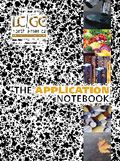A Highly Selective Method for the Analysis of Drospirenone in Human Plasma
The Application Notebook
Several common birth control formulations contain both drospirenone and ethinyl estradiol. A highly selective and sensitive analytical method for the analysis of drospirenone in human plasma has been developed for use in bioequivalence studies. The solid-phase extraction (SPE) and UPLC®–MS–MS methodologies are described as well as performance against validation parameters.
Several common birth control formulations contain both drospirenone and ethinyl estradiol. A highly selective and sensitive analytical method for the analysis of drospirenone in human plasma has been developed for use in bioequivalence studies. The solid-phase extraction (SPE) and UPLC®–MS–MS methodologies are described as well as performance against validation parameters.
The challenges of developing a bioanalytical method revolve around meeting the rigorous criteria set forth in the FDA Guidance for Industry for Bioanalytical Method Validation. Methods need to be acceptable in terms of linearity, sensitivity, selectivity, accuracy and precision, stability, and carryover. Recently, the FDA has also included a more comprehensive set of guidelines relating specifically to the assessment and quantification of matrix effects. Effective, highly selective sample preparation is an important component in the minimization of matrix effects and sample variability.
A bioanalytical method for drospirenone, a component of common birth control formulations, was developed to perform bioequivalence studies on generic replacements. Several methods exist for the analysis of ethinyl estradiol,(1–5) but this is believed to be the first reported method for drospirenone.
We describe sample preparation and chromatographic techniques for the analysis of the two synthetic hormones (drospirenone and ethinyl estradiol), and validation data for the analysis of drospirenone.
In this work, we employ mixed-mode SPE to more selectively separate drospirenone and ethinyl estradiol from matrix components. Subsequent analysis was performed by UPLC–MS–MS. Structures for the analytes are shown in Figure 1.

Figure 1

Directly inject elute 1. Dry down elute 2 and reconstitute in 50 mL of 10 mM sodium bicarbonate buffer, pH 10.5, add 50 mL of 1 mg/mL dansyl chloride solution in acetone and derivatize at 60°C for 20 min.
Results and Discussion
Mixed-mode SPE is highly selective and has been shown to be a very powerful tool in reducing matrix effects for bioanalytical assays (6). As this method is to be used in the determination of bioequivalence, it must meet all of the FDA requirements for validation, including the recent guideline relating to variability of matrix effects. The FDA now recommends that matrix effects be quantified in six sources of matrix and that the variability in matrix effects not exceed ±15%. Variability of matrix effects was determined to be less than ±15% across all sources (Table I).

Table I: Calculated matrix effects for drospirenone in six sources of human plasma prepared by mixed-mode anion exchange SPE
We included four individual donors and two lots of pooled plasma in the analysis to prove that the assay is selective for drospirenone. Minimization of variability across different sources of matrix (i.e., individual subjects in clinical studies), has been a major point of discussion in relation to incurred sample reanalysis (ISR.) Many researchers believe matrix effects arising from sample variability are one of the primary causes for failure in repeat analysis.
SPE recovery was calculated for both drospirenone and ethinyl estradiol. Drospirenone was found in elution 1 (the reversed-phase elution) as expected and ethinyl estradiol was found in elution 2 (bound by anion exchange to the resin). Analyte SPE recovery and RSDs are shown in Table II.

Table II: SPE recoveries (n 5 8) and RSDs for drospirenone and ethinyl estradiol.
The method is linear (1/x weighting) for the determination of drospirenone in human plasma from 0.5 to 250 ng/mL. Correlation coefficients were greater than 0.997 and % deviations from the actual concentrations were less than 15%, including at the lower limit of quantification (LLOQ). Sensitivity at the LLOQ of 0.5 ng/mL is shown in Figure 2. Calculated concentrations for QC's at 0.75, 25 and 200 ng/mL were all within 15% of expected values.

Figure 2
Conclusion
A sensitive, robust and reliable UPLC–MS–MS method was developed for quantification of drospirenone in human plasma to support a bioequivalence study. Matrix effects were virtually eliminated through the combination of mixed-mode SPE and UPLC–MS–MS. Combining SPE in a 96-well format with three min cycle times yielded sample throughput of over 400 samples a day without compromising data quality.
References
(1) N. Twaddle et al., J. Chromatogr., B, 793, 309–315 (2003).
(2) H. Licea-Perez et al., J. Chromatogr., B,8523, 69–76 (2007).
(3) M.R. Anari et al., Anal. Chem.,74, 4136–4144 (2002).
(4) W. Shou, X. Jiang and W. Naidong, Biomed. Chromatogr., 18, 414–421 (2004).
(5) W. Li et al., J. Chromatogr., B,825, 223–232 (2005).
(6) E. Chambers et al., J. Chromatogr., B,852(1–2), 22–34 (2007).

Waters Corporation
34 Maple Street, Milford, MA 01757
tel. (508) 478-2000, fax (508) 478-1990

Pick Your Poison. Isolation of Paclitaxel (Mar 2025)
March 7th 2025The diterpenoid, paclitaxel, which was identified as a potent chemotherapy agent for breast and ovarian cancer originates from the Pacific Yew tree. The isolation of paclitaxel from its major impurities is shown with the use of Hamilton’s PRP-1 (5 µm) HPLC column.

.png&w=3840&q=75)

.png&w=3840&q=75)



.png&w=3840&q=75)



.png&w=3840&q=75)













